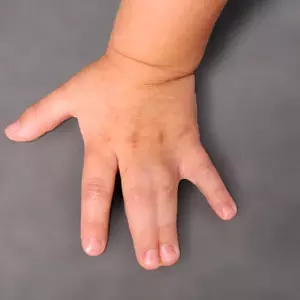- Home
- Patient Care
- Services
- Hand & Microsurgery
- Overview
- Congenital Hand Disorders
- Frequently asked questions about syndactyly
Frequently Asked Questions about Syndactyly
When should surgery be performed?
There are no firm guidelines on timing of surgery for syndactyly but some basic principles apply.

- Thumb-index finger syndactyly or ring-small finger syndactyly should be corrected early. Many surgeons will consider surgery between 3 and 6 months for these syndactylies.
- Index-long finger and long-ring finger syndactyly can be reconstructed in a more elective fashion. Many surgeons choose to operate between 12 and 16 months. the hand is bigger by that age (the hand doubles in size from birth to 2 years of age and nearly doubles once again by maturity), making reconstruction more straightforward. Some families object to waiting this long for surgery, but I believe the benefits of waiting are real.
Why can't the fingers be separated by cutting the skin between the fingers?
- The skin surrounding 2 joined fingers is not enough to cover the fingers when they are separate (apparently they taught us that in high school math: circumference = pi (r) squared).
- A straight line incision tends to scar in a band which tightens (contracts) over time.
- The skin at the base of the fingers (the commissure) is most likely to scar and must be reconstructed most carefully to look near normal and to prevent recurrent scarring or web creep.
How does the surgeon bring more skin to cover the newly separated fingers?
- One technique is to apply skin grafts to fill in the holes left after the fingers are separated. The skin grafts are full thickness which means that the entire thickness is taken and then the donor site is sutured back together in a straight line. The graft can be taken from different areas including the groin and the front of the elbow (my preference for several reasons).
- The other technique is to slide the skin from the top of the hand into the commissure (the new skin is the skin from the top of the hand). The technique avoids the need for skin graft and therefore is my preferred technique when possible. I like avoiding skin grafts.
What happens after surgery?
My preference (and that of many of my peers) is to place a bulky soft dressing on the hand and forearm (and maybe over the elbow). The child returns to clinic at 3-4 weeks for a dressing change and to initiate therapy.
What are the risks of surgery?
- Most surgeries are uneventful and the child does well with a satisfactory appearance after surgery and excellent function.
- Infection is a risk with any surgery. Sometimes a low grade infection can threaten skin grafts.
- Skin grafts and flaps may not survive after surgery. This complication is very rare.
- Web creep is perhaps the most notable risk. Web creep is scarring in the commissure between the fingers that lead to a partial "recurrence" of syndactyly.
- About 1 out of 3 children will need a second surgery. For some types of syndactyly, that number is higher.
How many surgeries will be necessary?
Usually, only one surgery is required for a syndactyly that affects only 2 fingers. However, about 1 out of every 3 patients will need another surgery - most commonly to deal with web creep.
What is different about complex syndactyly?
Complex syndactyly is most commonly a bony connection between the fingers near the fingernails. The reconstruction process is similar to cutaneous (or "simple") syndactyly but the fingers typically have a less satisfactory outcome. Even with appropriate surgery, the fingernails are often deformed and the fingers may be angled or rotated. Additional surgeries to straighten the fingers may be helpful in these children.
What is central polysyndactyly?
This is a complicated form of syndactyly. There is typically an extra portion of a digit between the long and ring fingers. this extra digit makes syndactyly reconstruction more challenging and increases the likelihood of additional surgeries. The separated fingers are more likely to be smaller than normal and may be angulated, rotated, or lack full motion.
What is Apert's syndrome?
This is a complex syndrome with abnormalities of the skull bone, facial appearance of hands/feet. The syndactyly that these children have is quite complex and often requires multiple surgeries to correct. A skin graft is usually required.
What is oculodentodigital dysplasia?
These children have a typical facial appearance including a narrow nose, small teeth, small eyes, syndactyly of the 3/4/5th digits, and may have neurological problems as well. Children with syndactyly of the 3rd, 4th and 5th fingers may be evaluated for this diagnosis.
What is symbrachydactyly?
The term means short, webbed fingers, at least that is the most common appearance. However, other children with a different appearance many also have symrachydactyly. Reconstruction of the typical syndactyly in these children is similar to the above discussion.
How is syndactyly in constriction band syndrome (or amniotic band syndrome) different from other syndactyly?
These children develop normal fingers in the womb but scarring leads to abnormal connections, typically at the fingertip. Reconstruction is different than what has been described, sometimes more straightforward.